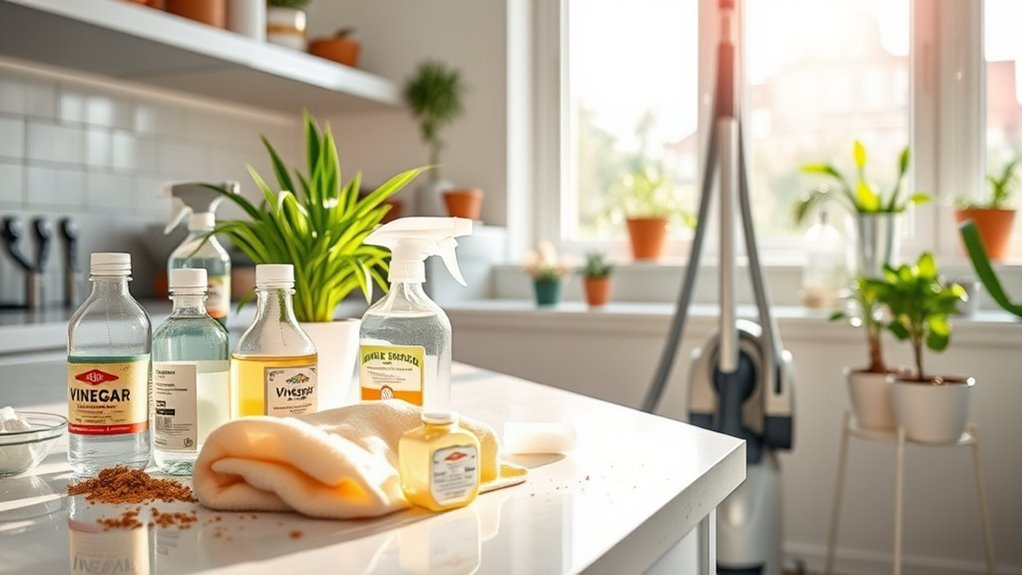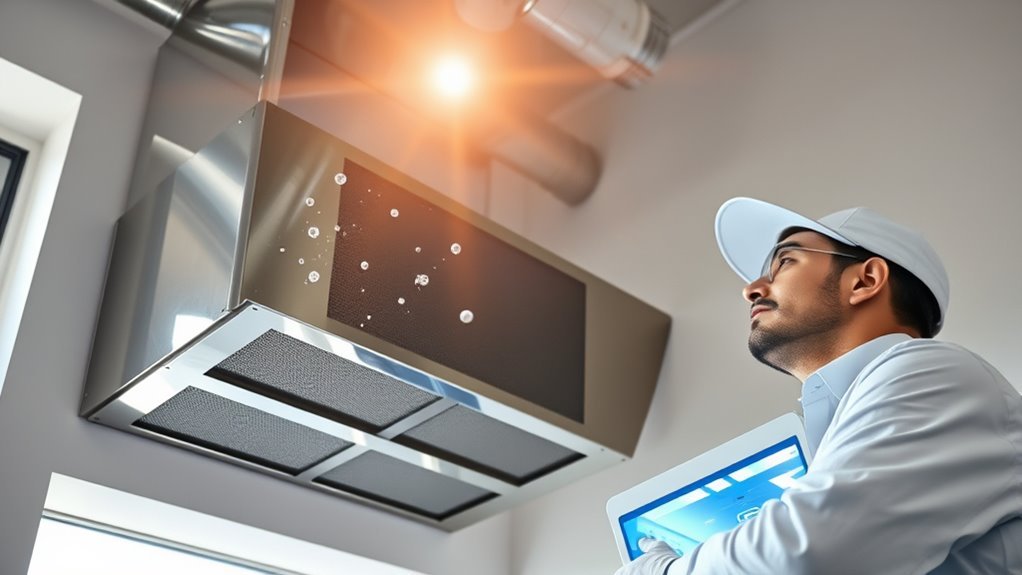Best Way to Sanitize Your Allergens
To effectively sanitize allergens, you should identify common triggers like dust mites, pollen, pet dander, and mold. Regularly clean high-touch surfaces and vacuum with a HEPA filter to trap allergens. Use hypoallergenic bedding washed in hot water and maintain indoor humidity below 50% to inhibit dust mites and mold. An air purifier with a HEPA filter enhances air quality. Consistent HVAC maintenance also prevents allergen buildup. Exploring these strategies further will reveal additional ways to optimize your indoor environment.
Identify Common Household Allergens

Allergens are substances that can trigger allergic reactions, and in your home, several common types are often responsible. You’ll find pollen sources entering through open windows or clinging to clothing, settling on surfaces and fabrics. These microscopic particles can provoke respiratory irritation, especially during peak pollen seasons. Additionally, dust particles, composed of skin cells, fibers, and microscopic organisms, accumulate in carpets, upholstery, and bedding. These particles often harbor dust mites, which exacerbate allergic responses. Identifying these common allergens in your living space helps you target their elimination effectively. By recognizing where pollen sources infiltrate and how dust particles gather, you can better manage your environment to reduce exposure and maintain your freedom from allergy symptoms. This initial understanding is essential before implementing sanitation strategies. Regularly cleaning high-touch surfaces can also help minimize allergen buildup in frequently used areas.
Effective Cleaning Techniques for Allergen Removal
To effectively remove allergens, you’ll need targeted cleaning techniques for dust mite elimination, mold prevention, and pet dander control. Regular vacuuming with a HEPA filter, using dehumidifiers, and washing pet bedding frequently are essential steps. These methods reduce allergen buildup and improve indoor air quality. Using microfiber cloths to trap dust and pollen can further enhance allergen removal and prevent dispersion into the air.
Dust Mite Elimination
Eliminating dust mites requires targeted cleaning methods that reduce their population and prevent allergen buildup. You’ll want to focus on dust mite habitats—bedding, upholstery, and carpets—where they thrive. Regular vacuuming with a HEPA filter and washing bedding in hot water above 130°F are essential for effective dust mite reduction. Maintaining low indoor humidity below 50% also discourages their growth.
| Cleaning Method | Target Area | Effectiveness Level |
|---|---|---|
| Hot Water Washing | Bedding | High |
| HEPA Vacuuming | Carpets and Upholstery | Moderate to High |
| Dehumidification | Entire Home | Moderate |
| Dust Mite Covers | Mattresses and Pillows | High |
| Frequent Dusting | Surfaces | Moderate |
Use these precise steps to reclaim your environment from dust mites efficiently.
Mold Prevention Strategies
Although mold growth often goes unnoticed until it becomes a problem, you can greatly reduce its presence by controlling moisture and using effective cleaning methods. Start by maintaining indoor humidity below 50%, using dehumidifiers and proper ventilation to inhibit mold growth. Address leaks or water intrusion immediately to prevent mold colonies from establishing. Clean affected surfaces regularly with EPA-registered mold cleaners or a solution of detergent and water. Avoid mixing bleach with ammonia or other cleaners, as this can produce harmful fumes. Porous materials with mold, such as drywall or carpet, may require removal to eliminate allergens fully. By implementing rigorous moisture control and targeted cleaning, you’ll minimize mold-related allergens, promoting a healthier environment and your freedom from respiratory irritation and allergy symptoms.
Pet Dander Control
While pet dander is a common allergen, controlling its presence requires consistent and targeted cleaning techniques. To effectively reduce dander, start by incorporating regular pet grooming into your routine; brushing your pet frequently minimizes loose fur and skin flakes. Use a vacuum cleaner equipped with a HEPA filter to capture microscopic dander particles from floors and upholstery. Wipe hard surfaces with a damp cloth to prevent airborne dispersal. Wash pet bedding and soft furnishings weekly in hot water to eliminate allergens. Additionally, maintaining proper ventilation reduces airborne dander accumulation. By combining these methods, you’ll achieve significant dander reduction, improving indoor air quality and allowing you to enjoy a freer, allergen-controlled environment. Consistency and precision in cleaning are essential to managing pet-related allergens effectively.
Choosing the Right Air Purifier for Allergy Relief
When selecting an air purifier for allergy relief, you need to focus on specific features that effectively capture airborne allergens such as pollen, dust mites, and pet dander. Understanding air purifier types and filter options is essential for maximum freedom from allergens. HEPA filters are highly effective, while activated carbon filters remove odors. Consider room size and noise levels for your comfort.
| Feature | Benefit |
|---|---|
| HEPA Filter | Captures 99.97% of allergens |
| Activated Carbon | Absorbs odors and gases |
| UV Light | Kills bacteria and viruses |
| Room Coverage | Matches purifier to room size |
| Noise Level | Guarantees quiet operation |
Choose a purifier that balances these features to reclaim allergen-free air efficiently. Regular filter maintenance is crucial to ensure your air purifier continues to effectively reduce pet allergens in your living space.
Importance of Regular HVAC Maintenance

Because your HVAC system plays an important role in circulating and filtering indoor air, regular maintenance is essential to guarantee it operates efficiently and reduces allergens. Neglecting HVAC filters allows dust, pollen, and other allergens to accumulate, diminishing air quality and system performance. You should replace or clean filters according to manufacturer guidelines to maintain ideal filtration. Additionally, professional duct cleaning removes trapped contaminants that contribute to indoor allergen levels and can impair airflow. By ensuring ducts are clean and unobstructed, you promote healthier air circulation throughout your living space. Regular HVAC maintenance not only preserves system longevity but also empowers you to breathe freely, minimizing allergen exposure and enhancing indoor comfort. Staying proactive with these tasks is vital for effective allergen control and maintaining your home’s air quality. Using air purifiers in conjunction with HVAC maintenance can further capture dust, allergens, and harmful particles to improve breathing comfort.
Using Hypoallergenic Bedding and Covers
You’ll benefit from using hypoallergenic bedding by reducing exposure to common allergens like dust mites and pet dander. Selecting covers with tightly woven fabrics and allergen-proof zippers guarantees effective barrier protection. Prioritizing these features helps maintain a cleaner sleep environment and minimizes allergic reactions. Additionally, washing bedding in hot water regularly ensures effective removal of dust mites and other allergens.
Benefits of Hypoallergenic Bedding
Although allergens are often invisible to the naked eye, using hypoallergenic bedding and covers can greatly reduce your exposure during sleep. Hypoallergenic materials are specifically designed to resist common triggers such as dust mites, mold spores, and pet dander. By incorporating these materials into your bedding, you create a barrier that limits allergen accumulation. This barrier not only improves your respiratory health but also enhances sleep quality by minimizing nighttime irritation. Proper bedding maintenance is vital; regular washing at high temperatures further reduces allergen presence. Choosing hypoallergenic bedding empowers you to control your sleeping environment, promoting freedom from allergen-induced discomfort. This approach is fundamental for maintaining a clean, sanitized sleep space without relying solely on chemical treatments or frequent deep cleaning.
Choosing Effective Covers
To maximize the benefits of hypoallergenic bedding, selecting the right covers is a key step. You’ll want cover materials that provide effective allergen blocking to prevent dust mites, pollen, and pet dander from penetrating your bedding. Look for tightly woven fabrics with a pore size small enough to block allergens while maintaining breathability.
Consider these factors when choosing your covers:
- Use microfiber or tightly woven cotton for superior allergen blocking
- Opt for covers with certified hypoallergenic labels
- Select waterproof or moisture-resistant materials to inhibit mold growth
- Choose covers resistant to wear for long-term protection
- Prioritize easy-to-clean fabrics to maintain hygiene
Natural Remedies to Reduce Indoor Allergens

When aiming to reduce indoor allergens, natural remedies offer effective alternatives to chemical cleaners. Herbal solutions and essential oils can neutralize allergens without harsh residues. For example, tea tree oil has antifungal properties, while eucalyptus oil helps clear airborne particles. Incorporating these into your cleaning routine promotes a healthier environment, granting you the freedom to breathe more easily.
| Remedy | Effectiveness |
|---|---|
| Tea Tree Oil | Antifungal, reduces mold spores |
| Eucalyptus Oil | Clears airborne allergens |
| Lavender Oil | Anti-inflammatory, calming |
| Baking Soda | Absorbs odors, neutralizes dust |
| Vinegar | Disinfects surfaces naturally |
Using these remedies strategically empowers you to maintain a sanitized home while minimizing chemical exposure. Proper dilution and precautions are essential to ensure safe use of essential oils especially around pets and sensitive individuals.
Managing Pet Dander and Allergens
Since pet dander is a common indoor allergen, managing it effectively is essential for maintaining air quality and reducing allergic reactions. You can take precise steps to control pet dander while preserving your lifestyle freedom.
Managing pet dander is key to cleaner air and fewer allergies without sacrificing your lifestyle.
Consider these strategies:
- Regular pet grooming to minimize loose fur and dander.
- Establish allergen barriers by restricting pets from bedrooms or carpeted areas.
- Use HEPA air purifiers to capture airborne allergens efficiently.
- Frequently wash pet bedding and soft furnishings in hot water.
- Vacuum with a machine equipped with a HEPA filter to remove embedded dander from floors and upholstery.
- Additionally, vacuuming and grooming combined regularly enhances allergen reduction for a cleaner home environment.
Tips for Preventing Mold and Mildew Growth
Although mold and mildew thrive in damp environments, you can greatly reduce their growth by controlling moisture levels in your home. Mold spores are ubiquitous and settle easily in moist areas, so maintaining effective humidity control is essential. Use dehumidifiers and guarantee proper ventilation, especially in bathrooms and basements. Fix leaks promptly and avoid water accumulation on surfaces. Keep indoor humidity levels between 30-50% to create an environment unfavorable for mold growth. Regularly clean areas prone to moisture with mold-inhibiting solutions. By consistently managing humidity and moisture, you limit mold spores’ ability to colonize. This proactive approach not only safeguards your living space but also promotes healthier air quality, giving you the freedom to live comfortably without the burden of mold-related allergens. Additionally, using mold-resistant paints can provide an extra layer of protection by creating barriers against mold spores.
Frequently Asked Questions
Can Allergen Sanitizers Harm Indoor Plants?
You should be cautious when using allergen sanitizers around indoor plants, as some chemicals can affect plant safety by damaging leaves or roots. To minimize allergen exposure without harming your plants, opt for products labeled safe for use near vegetation or use natural alternatives like diluted vinegar or baking soda. Always test a small area first and verify good ventilation to protect both your indoor environment and your plants’ health.
How Often Should Allergen Sanitizers Be Applied?
To maintain a harmonious environment, it’s wise to follow frequency guidelines tailored to your space’s needs. Typically, applying allergen sanitizers once a week suffices, but higher traffic areas might require more frequent attention. Employing precise application methods, like misting or wiping, guarantees even coverage without excess. By adhering to these practices, you liberate yourself from discomfort while preserving your surroundings’ integrity and promoting well-being with minimal intrusion.
Are UV Light Devices Safe for Allergen Removal?
You might wonder about UV light devices’ safety for allergen removal. UV safety is essential; these devices emit ultraviolet rays that can be harmful if misused. When operated correctly, they’re effective in reducing allergens like dust mites and mold spores. However, you’ll want to guarantee the device is certified and used according to guidelines to protect your skin and eyes. Proper use maximizes allergen effectiveness while maintaining your safety.
Do Allergen Sprays Affect Electronic Devices?
Think of allergen sprays like a double-edged sword—they can boost spray effectiveness but might harm electronic safety if not used cautiously. When applying these sprays near your devices, you risk moisture damage or residue buildup, which can impair function. To protect your electronics, avoid direct spraying; instead, spray onto a cloth first. This method guarantees you maintain both allergen control and the freedom to use your devices without worry.
Can Allergen Sanitizing Reduce Outdoor Pollen Impact?
Yes, allergen sanitizing can help with pollen reduction, especially when combined with outdoor cleaning efforts. By regularly cleaning outdoor surfaces and using appropriate sanitizers, you reduce pollen accumulation and limit its spread indoors. This proactive approach minimizes your exposure, allowing you greater freedom to enjoy outdoor activities without constant allergic reactions. Consistent pollen reduction through sanitizing supports a healthier environment, enhancing your comfort and well-being during high pollen seasons.






